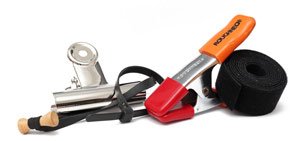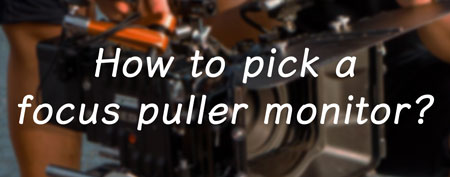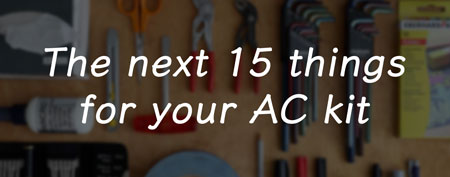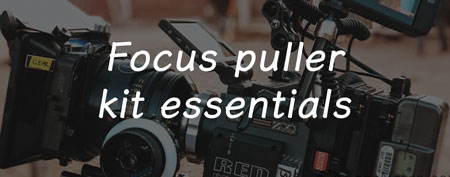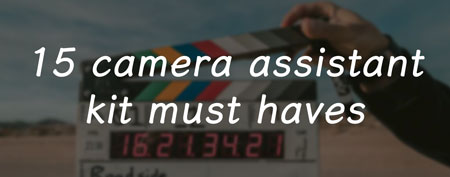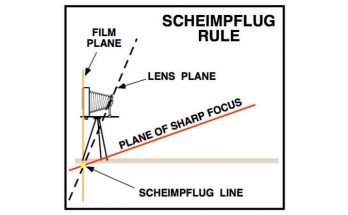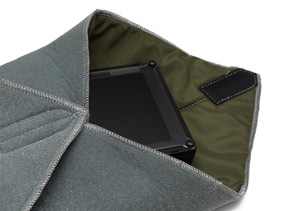Cinematography is a complex process combining craftsmanship with artistic vision. Capturing this vision on film (or in a digital file) requires a proficient crew and a fair amount of rather delicate equipment. To keep the gear and the crew behind it churring along happily, you need decent crafty and a bunch of consumables. At the end of the day, it all comes down to glorious gaff tape and the humble zip tie to keep things together. Continuously managing consumables is at the base of being a successful camera assistant.
Camera assisting is a consumable-intensive endevor, and every assistant has his or her preferences in terms of brands and types of consumables. Therefore, the initial consumables order which you make at the start of a project must be confirmed with all assistants involved. Of course, what you will be needing also depends largely upon the type of shoot you are embarking on. A studio-based sitcom is much different than an action packed location shoot with a couple of car stunts in the rain thrown in. This is where the experience of more senior camera department members can help you make an informed estimate of what expendables you will need to get.
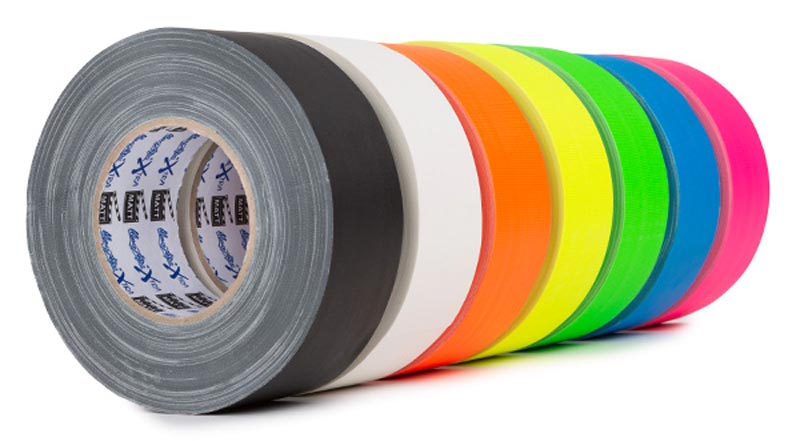
Tape
No one will ever question the importance of tape as a camera department consumable, so it’s a safe place to start building your list. You will be needing a bunch of different tapes anyway, so make sure you get these in early to reduce the chance of getting them slashed in a budget cut later on.
- Colored gaffer tape – by now you surely know how much of camera department work relies on color coding stuff with tape, so naturally you will be needing a few different colors. Make sure you get a good brand like Pro Gaff, Scapa, MagTape or ShurTape to avoid dealing with a sticky mess down the road.
- Black paper tape – For taping over mattboxes, blocking annoying lights, taping filters, black paper tape is an indispensible part of a camera assistant’s kit. Again, make sure it’s not just any random black tape. Look for tape that’s black on both sides, the Shurtape Photo Tape is a good option.
- Scotch Magic Tape is a must have for 1st ACs, it’s the perfect tape to cover those remote follow focus rings to prevent your marks from sticking around longer than intended.
- Gorilla tape – For when you really want to stick something down, Gorilla tape is a lot stronger than regular gaffer tape. It also fares much better in the wet, so if your shoot will be taking you out in the rain make sure you get a roll in your wet weather gear set.
- Rosco Matte Black Cinefoil – While not technically a tape, this item is usually sourced by the same suppliers. The matte black aluminium foil is mostly used by the lighting department, but it’s useful to have a roll in the camera consumables. From quick makeshift sunhoods to mattebox french-flag extensions, it has plenty of applications around cameras.
Batteries
Try to think of all the different devices and gadgets you and the rest of the camera crew will be using on set. We’re talking smart slates, flashlights, lightmeters, laser pointers, multimeters, laser tapes etc. For this it’s important to ask every camera crew member for his or her’s battery needs. The more popular options will be:
- AA – Apart from a bunch or random devices, most smart slates like Ambient or Denecke also use regular AA batteries. If it’s a long feature and you care about sutainability, try to organize the use of rechargeable AA batteries instead. You will feel much better at the end of the day without throwing out a handfull of batteries in the bin. Coordinate this with your friendly sound department for maximum impact.
- AAA – Many headlamps and compact flashlights use those, as do a lot of laser distance measures like AC favourite Hilti PD-E and many Bosch models. The Visible Dust Arctic Butterfly sensor brush also uses this size.
- CR123A – Many lightmeters use those, including the popular Sekonic L-758D and L-558 models. They are also found in some laser pointers or smaller flashlights.
- 9V – Mostly used by sound guys nowadays, you’ll also find 9V in some multimeters. Some quirky pieces of gear like the Heden Carat may also use 9V. As these are not used as much, they may end up staying in your kit for a while, so get good quality lithium ones that will not expire quickly.
- Coin batteries – Smaller devices like the Visible Dust Quasar sensor loupe or the UNI-T UT120C pocket multimeter often use coin batteries. Both of these use the popular CR2032 size, but make sure you also get a variety multipack to be prepared for any eventuality.
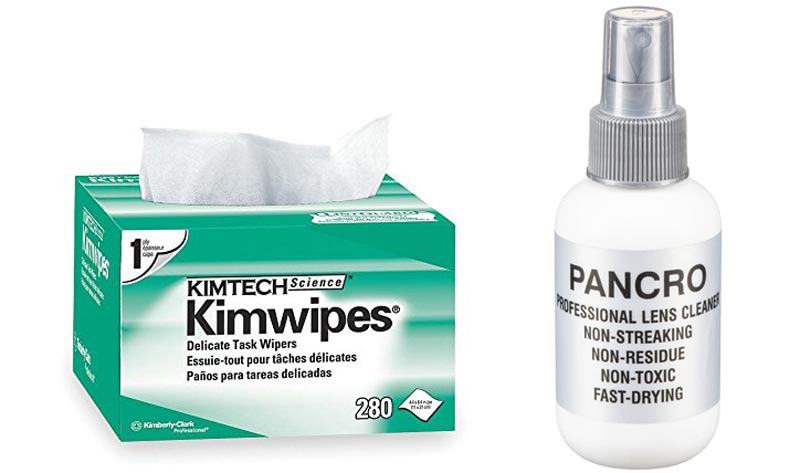
Lens & Sensor care
Keeping lenses and sensors spotless is at the top of a camera assistant’s duties. Cleaning a lens, filter or (god forbid) a sensor is one of the most delicate tasks you will undertake on set. Taking your time and ensuring you have all the top notch expendables at your disposal is paramount to avoid a disaster. Different ACs have different preferences when it comes to cleaning supplies, but here’s the most popular choices:
- Lens tissue – Kimtech Kimwipes Delicate Task Wipers are the lens tissue of choice for most camera assistants and technicians. The small boxes are preferred for on-set lens cleaning, while the large ones are prefered when you have to clean bigger surfaces like 6×6 filters for example. Some ACs may also prefer the Rosco or Tiffen lens tissue pads.
- Lens fluid – Lens cleaning fluids are another staple in which you might get different preferences. ROR (Residual Oil Remover) is a popular choice, as are Pancro and Eclipse. Panavision sells their own Calotherm lens fluid in a handy spray bottle.
- Compressed air – Depending on your location (or where the shoot is taking place) you might find different options for compressed air. Shipping restrictions may limit your choices. Falcon Dust-off Classic is one of the best options available in the US. Stay away from the plastic nozzled single-use version as they are not very reliable. Kenair is the preferred brand in the UK and EU.
- Sensor swabs – Visible Dust sensor swabs are the most popular option, combined with their sensor cleaning fluid. Sensor cleaning is not a task for the faint hearted, so only attempt it if you know what you are doing. For best results, you’ll be needing an Arctic Butterfly sensor brush and the Quasar sensor loupe.
- Lenspen – A bit of a controversial item, some camera assistants swear by it while others cringe at the very sight. Do check up with your crew to see whether you need to add a couple of those in the basket.
- Microfiber cloths – As an addition or a substitute to single-use lens tissue, microfiber cloths are another item which some ACs prefer over paper. Both Arri and Panavision sell dedicated microfiber lens cleaning cloths, another popular choice is the English Selvyt cloth.
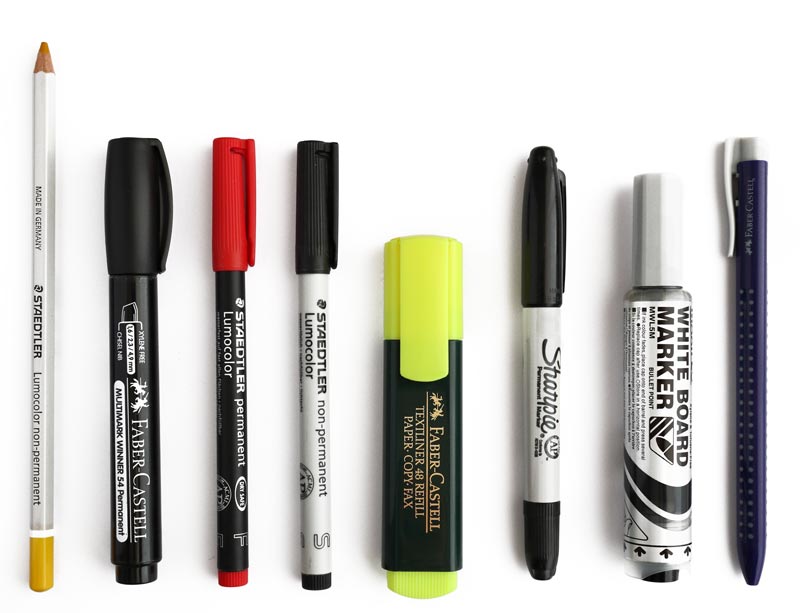
Pens & Markers etc.
- Sharpies – Or your choice of a permanenta marker. Pretty self-explanatory why you need those, the twin tip ones are nicer or get a selection of thick and fine tip ones.
- Whiteboard markers – Thick ones for marking the slate, Avery’s Marks-a-lot is the best we’ve used. Thin ones for focus pullers marking follow focus disks and rings, the Staedtler Lumocolor are the usual go-to.
- Regular pens – for filling out paperwork – deal memos, overtime sheets, camera reports, etc. Again, have multiple as you’re bound to lend it to someone and never see it again. Camera assistants are the first people anyone on set goes to for pens and markers. A nice, smooth rolling pen will earn you extra brownie points with a script superviser or an AD in distress.
- Pencils – For when all else fails! If you have to fill in camera reports the old school way, doing it in pencil means you can easily go back and change stuff you mess up (unless you are dealing with a carbon-copy pad in which case you’re screwed).
- Highlighters – makes going over equipment and shipping lists that much easier.
- Chinagraph pencils – mostly used by 1st ACs for making focus marks on lens barrels, it’s useful to keep those handy.
- Chalk – For marking actors on tarmac or pavement, temporary marking a camera’s position etc.
Labeling & Organization
Organization is key to good camera assistant work, so many experienced ACs rely on labeling systems and color coding to sort their kit and equipment.
- Brother P-Touch Cartridges – The Brother P-Touch system is the most popular labeling solution, and you’re bound to find at least one of those printers on every big set. This is why P-Touch cartridges are present in pretty much every feature expendables order. There’s two widths available – 12mm (1/2″) and 24mm (1″), and not all printers support both so double check which ones you will be needing.
- Color dot stickers – Extremely useful when separating equipment by camera units. A bit kinder on equipment than gaffer tape, these can usually be removed without residue even after quite a while.
- Boxes – Well, all of this has to go somewhere, and a cardboard shipping box won’t cut it for long. To be effective, you need to organize, label and sort it all, and for this you need clear plastic boxes. The Really Useful Box system is the best we’ve used.
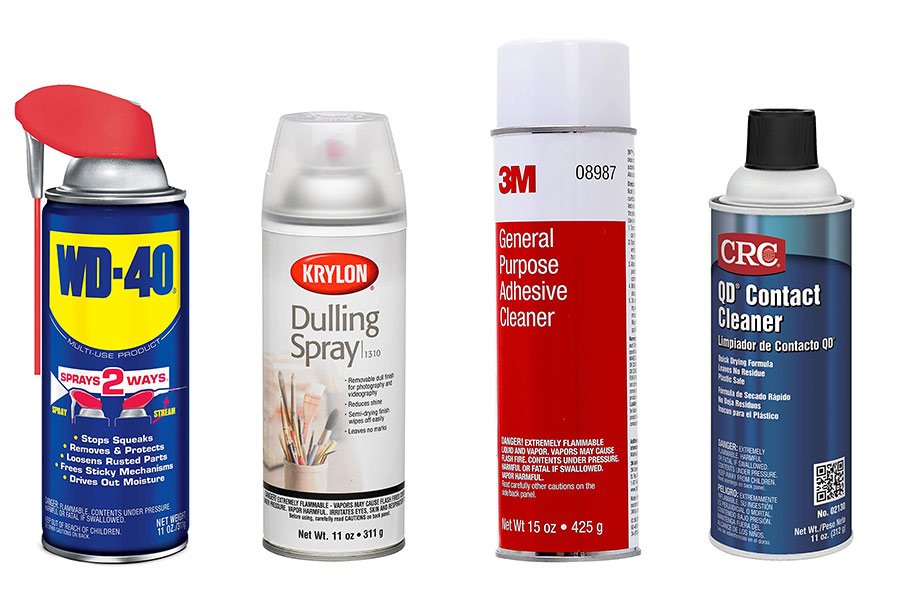
Aerosols
- WD-40 – Gaffer tape’s archenemy, WD-40 will remedy stuff like gritty tripod legs or squeaky case lids. Of course, you can also use your preferred brand of penetrating spray oil. Pro tip! If you want to make friends in the grip department, order a couple of extra cans and trade them when you need to ask a special favor.
- Label remover – Labeling is all fine and neat until you have to pull that piece of tape someone has slapped on a piece of gear two features ago. A can of label remover is worth it’s weight in gold in these cases, so make sure you have a good one handy.
- Contact cleaner – A lot of electrical gremlins can be chased down to bad contact, so a can of contact cleaner is a must in your expendables order.
- Dulling spray – For those close up shots of shiny objects, you’ll know when you need one. Sometimes set dressing or props will have one too, but it’s best to be prepared.
Wet weather gear
Wet weather gear is a somewhat optional consumables category, in that it may not be necessary with shoots that are entirely studio based with no practical rain scenes whatsoever. However, those jobs are few and far in-between so, chances are, you will need to be prepared for some adverse weather.
- Clear plastic bags or sheets – With a bit of tape and some self-adhesive velcro clear plastic sheeting can be made into all sorts of custom rain covers for any piece of equipment. Film expendable suppliers usually have 6-mil clear poly bags for this, or you can order up some clear vinyl for an extra clear, more durable result. Clear shower curtains are another good source for this material.
- Clear shower caps – Ideal for covering smaller things like viewfinders, onboard monitors etc.
- Cling film – When you’re dealing with a particularly torrential downpour, or maybe rigging a camera onto a car in the rain, you might need a bit more protection in some parts. Cling film is perfect to wrap around any exposed parts your rain covers might not seal, or any exposed connectors etc. The original Saran Wrap is by far the best.
- Chamois – Chamois aka shammy is another important addition to your wet weather kit. Super absorbent and fast drying, it’s commonly clipped to the front edge of the mattebox when shooting in the rain. Once there, it absorbs or wicks away any water that might otherwise start pouring right infront of the lens.
- Wypall X60 Blue Roll – For all heavy-duty cleaning and drying.
- Rain-X & Anti-fog – Spend enough time in the wet with a camera, and you will start getting some droplets on the ND or some fogging in your mattebox. These products are a must for your wet-weather bag.
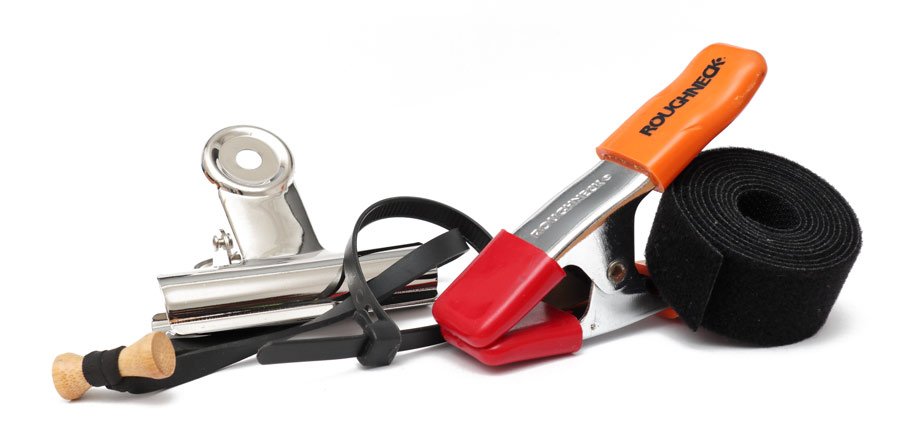
Fasteners & Rigging AKS
- Assorted clips & Clamps – These are used for a variety of tasks, and therefore you need a bunch of different shapes and sizes. Smaller clips are used to hold raincovers in place, to hang a chamois to dry or hold a piece of black wrap onto a mattebox. Larger clamps are generally used more by lighting and grip crews, but it’s useful for camera assistants to have a few around.
- Bongo ties – A camera department classic, these get used for all sorts of tasks from harnessing rogue cables to rigging small pieces of equipment. They even come in different colors to further your color coding efforts.
- Releasable zip ties – Another staple item, these can be found in multiple lengths in any camera assistant’s bag. If you want to impress the grips, grab some fancy rubber coated ones.
- Adhesives – Even if you are careful, stuff breaks on set. Better be ready to patch things up and carry on. Superglue is a given, but we also like to have some 2-part epoxy for bigger jobs. Removable threadlocker is also nice to have for those screws that just won’t stay tight.
- Self adhesive hook & loop tape – The best thing to happen to camera rigging since the invention of the 1/4″ screw, self adhesive hook and loop tape is a godsend. It comes in rolls of different widths and even different colors for ultimate swag.
- Double-sided hook & loop tape – The softer alternative to zip ties, this tape can be cut to size to tie everything from a couple of cables to a battery on a C-stand. This, too, comes in different colors, so make sure you order accordingly.
- Ratchet straps – Always useful to have a few. While grips usually take care of all the rigging and securing on set, at the very minimum camera crew does have to secure carts in the truck or van. Make sure you get some that are long enough for the task.
Miscellaneous
- Power strips – Whether you’re fitting out a production truck or a camera storage room for the duration of your project, chances are you will end up with more plugs than outlets. Be prepared with a few power strips, but do observe load ratings. If you are unsure, consult your friendly sparky, they will be glad to help prevent a dropped fuse (or worse).
- Viewfinder Covers – these items (also known as teddy bear assholes) are a more specific and harder to find expendable. They go over the rubber cushion of the camera’s viewfinder, making looking through it both more pleasant and sanitary for the camera operator. The cushions need to be changed regularly, especially in hot weather. Make sure you order the correct shape and size cover to fit over the viewfinder of the camera you will be working with. Budget for enough of these to change them at least once a day per camera, with a few spares thrown in for good measure.
So there you have it, a list of expendables to get you through any shoot.Unfortunately, much too often you have to defend your requests before a scrutinizing producer, so it’s important to be prepared for that. Frequently you may have to cut down your initial list or compromise on some items. Double-check quantities and factor in a safety margin. Specialized items frequently need to be shipped in, incurring additional shipping fees and lead times. A producer won’t be happy if you tell them you forgot to add a couple of cans of contact cleaner once the main order has already been dispatched. The never ending tug of war over batteries, tape and canned air is as much part of fillmaking as anything. So let’s have a look at what you can’t live without on a film set.
Every now and than you will chance upon a dream production with a sympathetic line producer and a generous expendables budget. For these rare cases, check out our next guide to see what little goodies may make your life easier.

